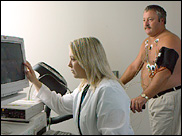A stress echo is a test that combines an ultrasound study of the heart with
a walking exercise stress test. It allows the doctor to learn how the heart
functions when it is made to work harder.
If you are scheduled to receive a stress test, you should register with Outpatient
Registration Area on the first floor of the Medical Center behind the Information
Desk. You should arrive approximately one hour before your scheduled stress
test time. Following registration, you will be directed to the Stress Lab on
second floor in Cardiopulmonary Services. The entire procedure takes about
one to one and half-hours.
To prepare for this test:

- No Solid Foods for Two Hours Before the Test
- Avoid Caffeinated or Decaf Coffee, Tea, Colas, Chocolate and
Cocoa 24 Hours Prior to the Test (You May Drink Water)
- Wear Slacks if Possible - No One Piece Jump Suits
- Take Medications as Scheduled with Small Sips of Water, Unless
Otherwise Instructed by the Ordering Physician
- Wear Comfortable Walking Shoes
- Bring a List of Medications, Including Dose and Frequency
You and the cardiologist performing the test must sign an informed consent.
Sticky patches are then applied to your chest and attached to an ECG machine
to monitor the heart throughout the test. You will then lie on your left side
on a special exam table. The echo technician will take ultrasound pictures
of your heart. These are stored on a disk and videotape for comparison later.
When the cardiologist arrives, you will start exercising (e.g. on a treadmill,
recumbent tricycle, etc.). The speed and/or incline will increase every two
to three minutes to increase the heart rate. When the physician feels the patient
has walked long enough or the heart rate is high enough, the treadmill will
be stopped. You will immediately move back to the exam table and lie on your
left side. The ultrasound pictures will be repeated. This is done to compare
the pictures done before and after exercise.
After the test, the cardiologist may give you a preliminary report. Some physicians
prefer to send the results to the ordering physician and the patient will have
to discuss the results with that physician instead.

